Clarification
and Qualification
Finally
the sun broke through the clouds, and Le Mans
steamed in Thursday's warm sunshine. After
three days of being soaked to the skin, it
was a pleasant change.
The
official day began with a Press Conference
from the ACO. Amongst the various announcements
made and topics discussed, one concerned a
clarification of the revised regulations relating
to engines and driver qualification. For the
first time this year a new regulation had
been imposed that stipulated that every team
had to nominate two engines for each car,
and that the engine they employed for qualifying
had to be the same one that the car used at
the start of the race. The penalty for changing
the engine after qualifying was to lose ten
grid positions in qualifying and face a three
minute stop-go penalty during the third hour
of the race.
The
tradition - almost from time immemorial -
has been to fit a new race engine on Friday,
so this new regulation was met with howls
of protest up and down the pitlane. After
all, an engine that had done six hours of
free practice on Wednesday, and then perhaps
another four on Thursday, is unlikely to be
in the peak of fitness for a 24 hour race.
The thinking behind the revised regulation
had been to deter teams from fitting highly-tuned
qualifying engines simply in order to set
a quick time, and then replace them with a
more standard (and reliable unit) for the
race. At a time when the ACO is trying to
level the financial playing field, and promote
motorsport as a more environmentally responsible
sport, the idea is sound. Teams with more
money could more easily afford the luxury
of a dedicated qualifying engine, but in practice,
the regulation was just as likely to penalise
those teams with smaller budgets.
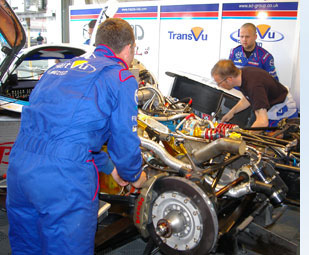 On
1st June the ACO published a clarification.
This stated that the teams had use of two
designated engines, as previously, but that
these engines could be swapped and changed
as and when the teams saw fit, without penalty.
However, if a third engine was required, the
team would incur a new and different penalty.
Anyone needing to fit a third engine would
begin the race from the pitlane, but fifteen
minutes after the official start. Although
this communiqué was distributed to
team managers, it was not made generally available,
and even as late as Wednesday evening,there
were many in the media and elsewhere, even
within teams, who still understood the previous
stipulation to be in force. Appreciating this
to be the case, the ACO issued a further clarification
on Thursday morning.
On
1st June the ACO published a clarification.
This stated that the teams had use of two
designated engines, as previously, but that
these engines could be swapped and changed
as and when the teams saw fit, without penalty.
However, if a third engine was required, the
team would incur a new and different penalty.
Anyone needing to fit a third engine would
begin the race from the pitlane, but fifteen
minutes after the official start. Although
this communiqué was distributed to
team managers, it was not made generally available,
and even as late as Wednesday evening,there
were many in the media and elsewhere, even
within teams, who still understood the previous
stipulation to be in force. Appreciating this
to be the case, the ACO issued a further clarification
on Thursday morning.
Another
matter eventually cleared up, but not until
Thursday morning, was the question of driver
qualification. Since Wednesday's session was
technically free practice, and not qualifying,
times set during those six hours could not
be considered as contributing towards a driver's
need to set a time within a fixed percentage
of overall pole. That requirement still had
to be met on Thursday evening, during official
qualifying. However, because they are not
time-related, the "night laps" completed
by a driver on Wednesday do contribute towards
his (or her, in Vanina Ickx case) need to
complete three timed laps during the designated
period of darkness, after ten o'clock.
The
official statement reads as follows:
Evidently,
this is still not clear enough, and even five
minutes before qualifying was due to commence,
two team managers interviewed on Radio Le
Mans gave contradicting interpretations; one
insisting that his drivers had not
done their night laps, even though they'd
done more than three on Wednesday, while the
second believed that they had. It is understood
that the latter is correct.
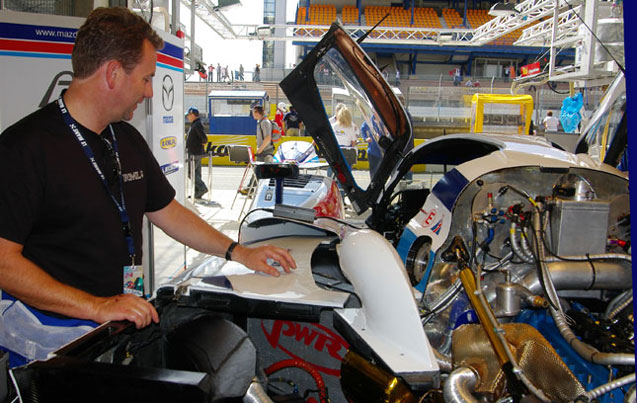
Qualifying
The
start for official qualifying for the 77th
running of the Le Mans 24 Hours was delayed
for 24 minutes after an incident during the
previous session, when one of the Formula
Le Mans Oreca prototypes had an off into the
barriers, and the Armco took some time to
be repaired. It was confirmed shortly after
the session began that the period would be
extended to 21:25 to ensure two full hours
before darkness fell.
At
19:24 the first cars began streaming out of
the pitlane, headed by two of the three Gulf-liveried
Lola Aston Martins. Tommy was there with them
a few seconds later, under instructions to
complete a single installation lap. He completed
that, declaring that "everything feels
OK," as he entered the pitlane. The team
checked camber on all four wheels, and quickly
whipped the engine off to ensure that everything
there was functioning OK. Tommy was also able
to confirm that the changes made to the car's
aero since Wednesday had worked as planned,
and the car felt less draggy on the straights.
Checked
and passed as fit, Tommy eased the Lola Mazda
back out on track, knowing he had to do three
timed laps before returning to the pitlane.
Ten
minutes completed, and with Tommy yet to do
a flying lap, overall quickest was Darren
Turner in the 008 Aston. Fastest in LMP2,
Guy Smith in the ASM Ginetta-Zytek. Heading
GT1, Oliver Gavin in the #64 Corvette, and
topping the list in GT2, young Jonny Cocker
in the Drayson Racing Aston Martin Vantage.
The
out-lap from Tommy, a 6:52.422 including the
pitstop, gave him 35th overall. His first
true flyer, a 3:48.394, threw the Lola well
up the screens, to top out at 16th overall,
third in LMP2 behind Emanuel Collard, fastest
in the Team Essex Porsche Spyder (on 3:40.796)
and Guy Smith's 3:46.866.
Tommy's
second timed lap was a slower 3:48.394, but
on his third and final lap during this period
he managed two "green" first sectors
- the lights on the timing screen revealing
that he'd covered those sectors quicker than
previously - and crossed the line in a time
of 3:45.478 to regain 4th in class. Reminded
by Phil Barker to "come in this time
please Tommy," the Brazilian confirmed
that he was "in this lap" and returned
to the pitlane at 19:54 pm.
Half
an hour gone, and the situation in LMP2 had
Collard still leading with a 3:39.948, with
Sasha Maassen second in the Team Goh Spyder,
3:43.114, and Jonny Kane third with a best
of 3:43.744 for the #33 Speedy Sebah, narrowly
ahead of Tommy's 3:45.478.
Tommy
was in the garage for almost ten minutes while
some minor adjustments were made to the car,
and then returned to the rack at 20:05, with
permission from Phil to do two more timed
laps. He rejoined not long after Guy Smith
had improved the best from the #40 ASM Quifel
Ginetta-Zytek by posting 3:44.298, demoting
Tommy to fifth.
Despite
complaining of traffic, Tommy managed a fastest
middle-sector on his out-lap, and then followed
this by a new quickest lap on his first flyer,
setting 3:44.432. It wasn't an improvement
in position, but it suggested there was more
to come. It was 20:18 pm as he headed back
to the pits, where the team carried out a
further series of tweaks and refuelled the
car.
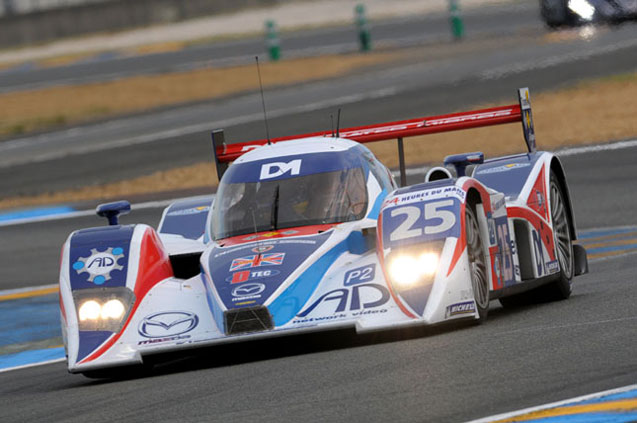
One
hour completed, and situation was:
Franck Montagny fastest overall in the #8
Peugeot on 3:25.608, followed by Alexander
Primat in the #3 Audi R15, two seconds behind,
and Pedro Lamy third in the #7 Peugeot. In
LMP2, no change from previously, with #31
leading the pack on 3:39.948, followed by
the Goh Spyder and then the Speedy Lola, narrowly
ahead of RML in fourth.
In
GT1, the fastest time had been set by Jan
Magnussen in the #63 Corvette at 3:57.114,
ahead of team-mate Olivier Beretta the #64,
and then the first of the Luc Alphand Corvettes
third, but three seconds behind the factory
cars. In GT2, Marc Lieb topped the class in
the #77 Felbermayr Porsche (4:05.854) from
Pierre Kaffer in the #82 Ferrari, and the
Team AF Corse Ferrari third.
Tommy
returned to the fray at 20:30 with a full
tank and a track that was heavily infested
by traffic. Neither factor was conducive to
quick times, but that wasn't his objective,
although 3:45.718 in race trim was a very
healthy pace. Happy that the car was handling
comfortably, he'd be handing over soon to
Mike.
Mike
took to the track at 20:48pm, and began a
series of successively quicker laps, topping
out with a personal best of 3:58.648. He returned
to the pitlane with the car on 20 laps total
at 21:12 for a refuel and driver-change to
Chris Dyson.
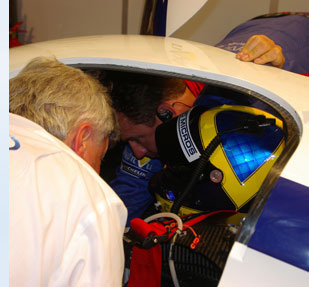 Chris
Dyson began his out-lap at 21:16 with the
plan for him to run to the flag. The RML Lola
Mazda was still holding fifth in class, and
Chris's had time for just one flying lap;
a 3:56.922.
Chris
Dyson began his out-lap at 21:16 with the
plan for him to run to the flag. The RML Lola
Mazda was still holding fifth in class, and
Chris's had time for just one flying lap;
a 3:56.922.
Chris's effort was somewhat eclipsed by the
round of applause that rippled around the
track when Allan McNish in the #4 Audi R15
finished the session with a time of 3:23.650
to take provisional pole, at the end of the
first two hours, with a time of 3:23.650,
a full second quicker the time set by Bourdais
in the #8 Peugeot.
Second
Period
As
the clock ticked up towards ten o'clock, there
was a flurry of activity within the RML pit
garage, as Tommy was returned to the car and
the pre-heated slicks - the closest the team
will get to qualifiers this year - were rapidly
fitted to the car.
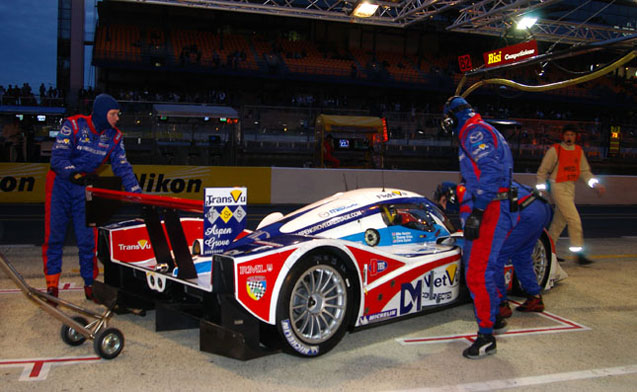
At
10:03, with a blip of the throttle, the red,
white and blue Lola sped out of the pitlane.
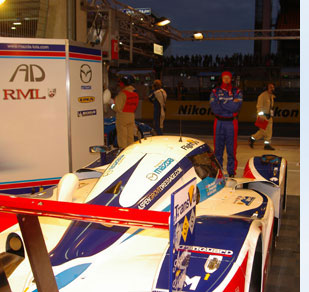 The
opening half hour after the break, when the
track temperature is still high and the light
is fairly good, is often the period when the
quickest times are set, and Tommy was keen
to make the most of the opportunity. That
was denied him on his first lap, when he encountered
heavy traffic. He told Phil Barker over the
radio, who reassured the Brazilian that all
that was expected of him was to "do his
best". "Thankyou," came the
brief reply.
The
opening half hour after the break, when the
track temperature is still high and the light
is fairly good, is often the period when the
quickest times are set, and Tommy was keen
to make the most of the opportunity. That
was denied him on his first lap, when he encountered
heavy traffic. He told Phil Barker over the
radio, who reassured the Brazilian that all
that was expected of him was to "do his
best". "Thankyou," came the
brief reply.
To
prove the point, his opening lap was a 3:49.976,
whereas the #41 Zytek (with Philip Peter in
the cockpit) did make an improvement, closing
to within a second of Tommy's earlier time.
Jonny Kane also improved his time in the #33
Lola, clocking 3:43.226 to secure third in
class.
Tommy's
second lap was significantly different, however,
and a 3:43.552 was enough to snick through
into fourth, leap-frogging Olivier Pla in
the #40 ASM Ginetta-Zytek. But the Frenchman
was immediately onto a responding charge,
and followed through moments later to record
3:42.012 and lay claim to third in LMP2.
As
predicted, the action continued for several
more minutes. Next to improve was Andrea Piccini
in the #30 Racing Box Lola. A time of 3:42.848
from the Italian was enough to deny both Kane
and Erdos of their position and reserve fourth
place. Encountering further traffic on his
next lap, Tommy could do no more than a 3:43.976,
despite a fastest third sector, and that was
it, attempt over. He was lying sixth in class.
On
the next lap, Tommy returned to the pitlane
and was immediately called in to the weighbridge
for a quick checkup. It was 10:23, and the
focus now was to get the other two drivers
back into the car and ticking off their three-lap
"night lap" requirement completed
as soon as possible.
Mike
completed three timed laps, as requested,
clocking a best of 4:03.556. In the meantime,
the situation throughout the grid had settled
down, and the frenetic action of that first
half hour after the break had eased to a trickle
of occasional sector improvements and fresh
places for the lower orders. Qualifying wasn't
exactly settled, but there was a feeling that
there wasn't a great deal more to come. Mike
pitted at 10:50 pm.
Final
Hour. Chris Dyson began his first
night session in the RML Lola cockpit a few
minutes later, just as Xavier Pompidou made
the first improvement for some while in the
#33 Speedy Sebah Lola, and followed that by
another - 3:41.724 was also enough to move
the blue and silver Lola up to third in class.
Chris
completed his three laps, with times that
improved with each tour, starting with a 55.196,
following on with a 55.060, and then ending
with a 3:50.832. At a time when few of the
other LMP2 runners were breaking four minutes,
this was an impressive run from the American,
making his race debut with RML.
Once
back into the garage, Tommy prepared to return
to the cockpit while the engineers made some
detail adjustments to the set-up. The Brazilian
would be sent out to evaluate the changes
during the last half-hour of the qualifying
session.
11:32
and Thomas Erdos threaded his way out of the
pitlane and began his final run of the day.
His return to the track was largely overlooked
while all eyes were following Stephane Sarrazin
in the #8 Peugeot which, for three successive
laps, set outright fastest first and second
sectors only to be baulked in the third, each
time quite innocently by an Audi. His best
lap; 3:23.728 was a mere tenth slower than
McNish's impressive pre-beak lap.
Tommy's
first flyer certainly started with promise.
Half a second up at the end of the first sector,
he continued in similar vein, clocking his
quickest second sector as well. Maintaining
his pace as best he could, he encountered
some traffic on the final run, but still crossed
the line in 3:41.952; a full second quicker
than he'd gone before. That moved the RML
Lola up two places to fourth in class. "The
car feels much better," declared Tommy.
"I think we have a very good car for
the race now."
Track
conditions were favouring the brave. Seconds
after Tommy set his fastest lap of the evening,
Sarrazin finally found the clear track he'd
been seeking, and crossed the line in a time
of 3:22.888 to reclaim a hold on pole for
Peugeot. His team-mate Nic Minassian then
set an improved time of 3:24.860 to reinforce
his hold on third, sandwiching the lead Audi.
Tommy returned to the pitlane. Ten minutes
of the session remained, but RML had called
it a day.
There
would be no further changes in LMP2, and pole
had gone to a Porsche RS Spyder once again,
but not the one that took the win in 2008,
but close rivals Team Essex, with the ex-Van
Merksteijn Porsche, now in the hands of Team
Goh, second, and the first of the Lolas third.
LMP2
Times - Qualifying
| Pos |
No. |
Overall |
Team |
Driver |
Car |
Time |
| 1 |
31 |
19 |
Team
Essex |
Collard/Elgaard/Poulsen |
Porsche
RS Spyder |
3:37.720 |
| 2 |
5 |
20 |
Team
Goh |
Ara/unimoto/Maassen |
Porsche
RS Spyder |
3:37.802 |
| 3 |
33 |
23 |
Speedy
Sebah |
Pompidou/Luenberger/Kane |
Lola
B08/80 Coupé |
3:41.724 |
| 4 |
25 |
24 |
RML
AD Group |
Erdos/Newton/Dyson |
Lola
B08/86 Coupé |
3:41.952 |
| 5 |
40 |
25 |
Quifel
ASM |
Amaral/Pla/Smith |
Ginetta
Zytek GZ09S |
3:42.012 |
| 6 |
30 |
26 |
Racing
Box |
Biagi/Bobbi/Piccini |
Lola
B08/86 Coupé |
3:42.848 |
| 7 |
41 |
27 |
GAC
Racing Team |
Ojeh/Gosselin/Peter |
Zytek GZ07S |
3:44.830 |
| 8 |
35 |
28 |
Oak
Racing |
Ajlani/Lahaye/Moureau |
Pescarolo
Mazda |
3:45.032 |
| 9 |
32 |
29 |
Barazi
Epsilon |
Barazi/Berville/Moseley |
Zytek GZ07S |
3:52.956 |
| 10 |
39 |
30 |
Kruse
Schiller |
Marsh/Noda
/dePourtales |
Lola
B05/40 |
3:53.072 |
| 11 |
26 |
33 |
Bruichladdich |
Bruneau/Greaves/Rostan |
Radical
SR9 AER |
3:55.320 |
| 12 |
24 |
36 |
Oak
Racing |
Nicolet/Hein/Yvon |
Pescarolo
Mazda |
3:57.524 |
In
LMP1, it was pole to Sarrazin in the #8 Peugeot,
with Audi #1 second, Peugeot #7 third, and
then the Pescarolo Peugeot #17 in fourth.
The fastest petrol-engined car is the 007
Aston Martin, 8th overall and narrowly ahead
of the sister 007 car with Strakka Racing's
#23 Ginetta-Zytek third. Yes, in many ways,
this is a class apart.